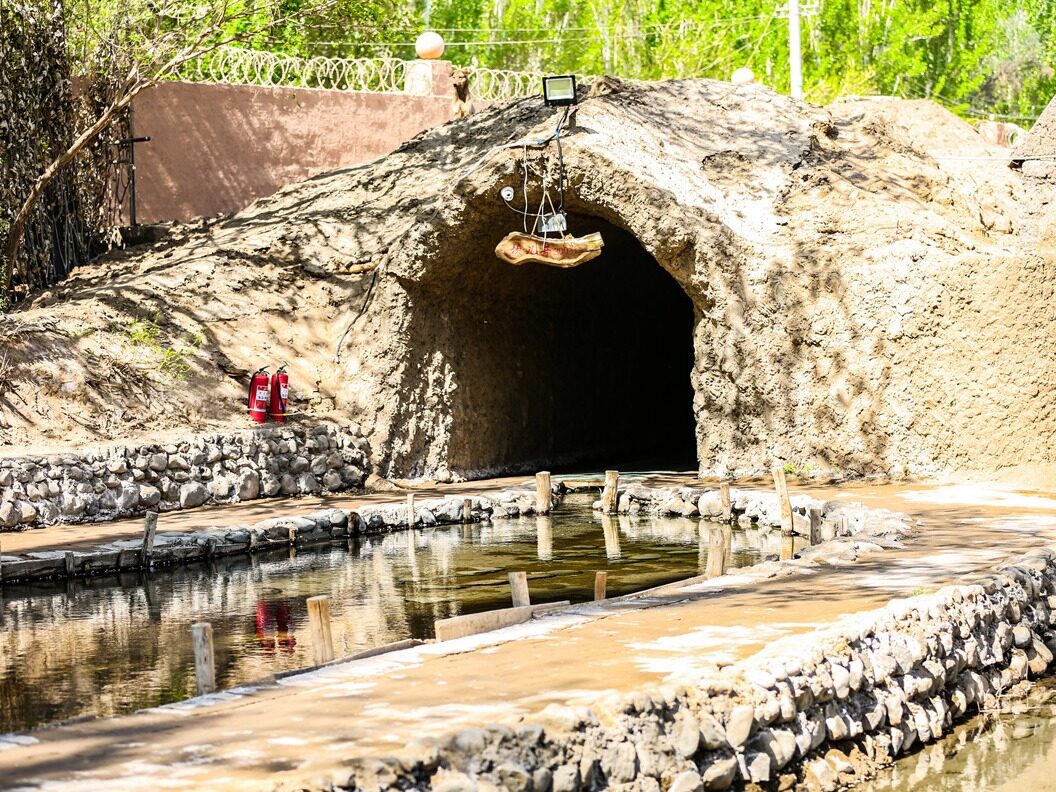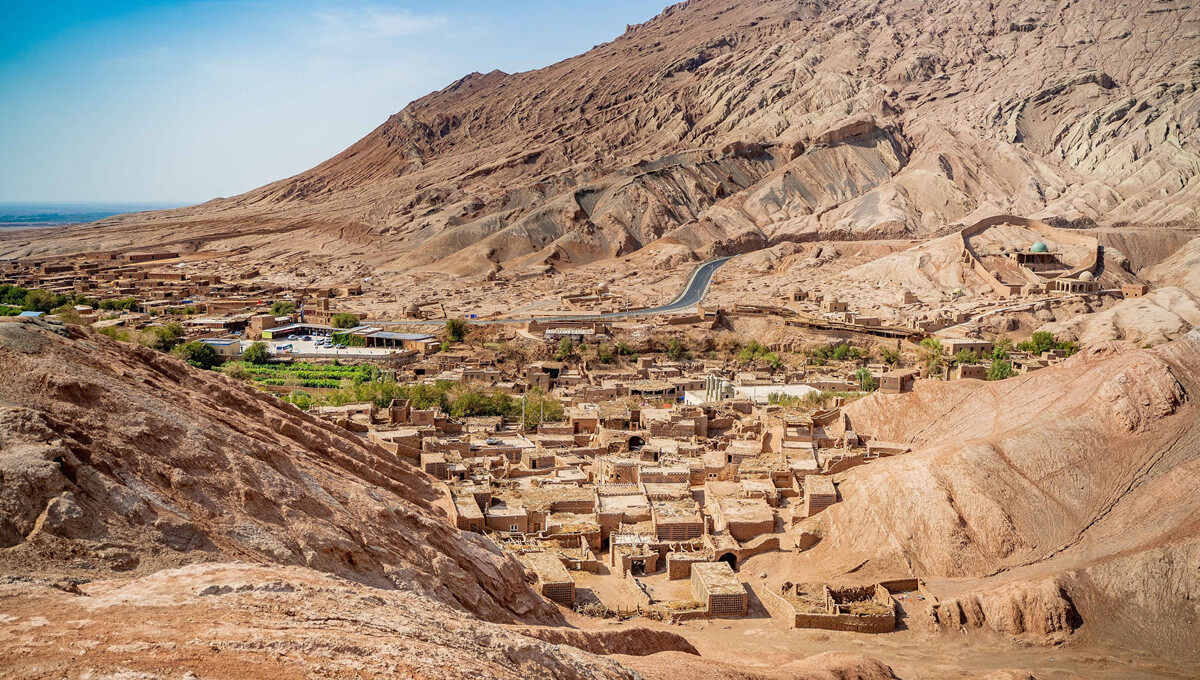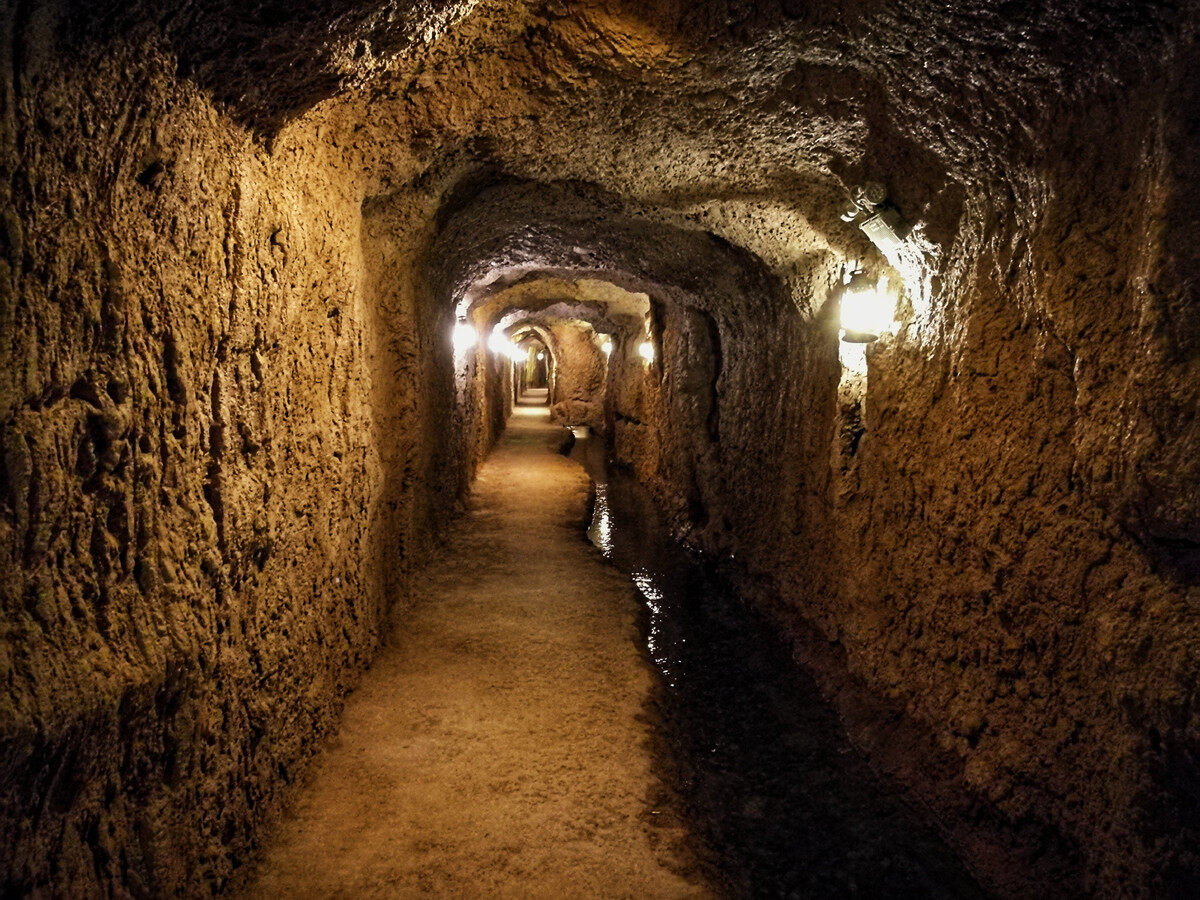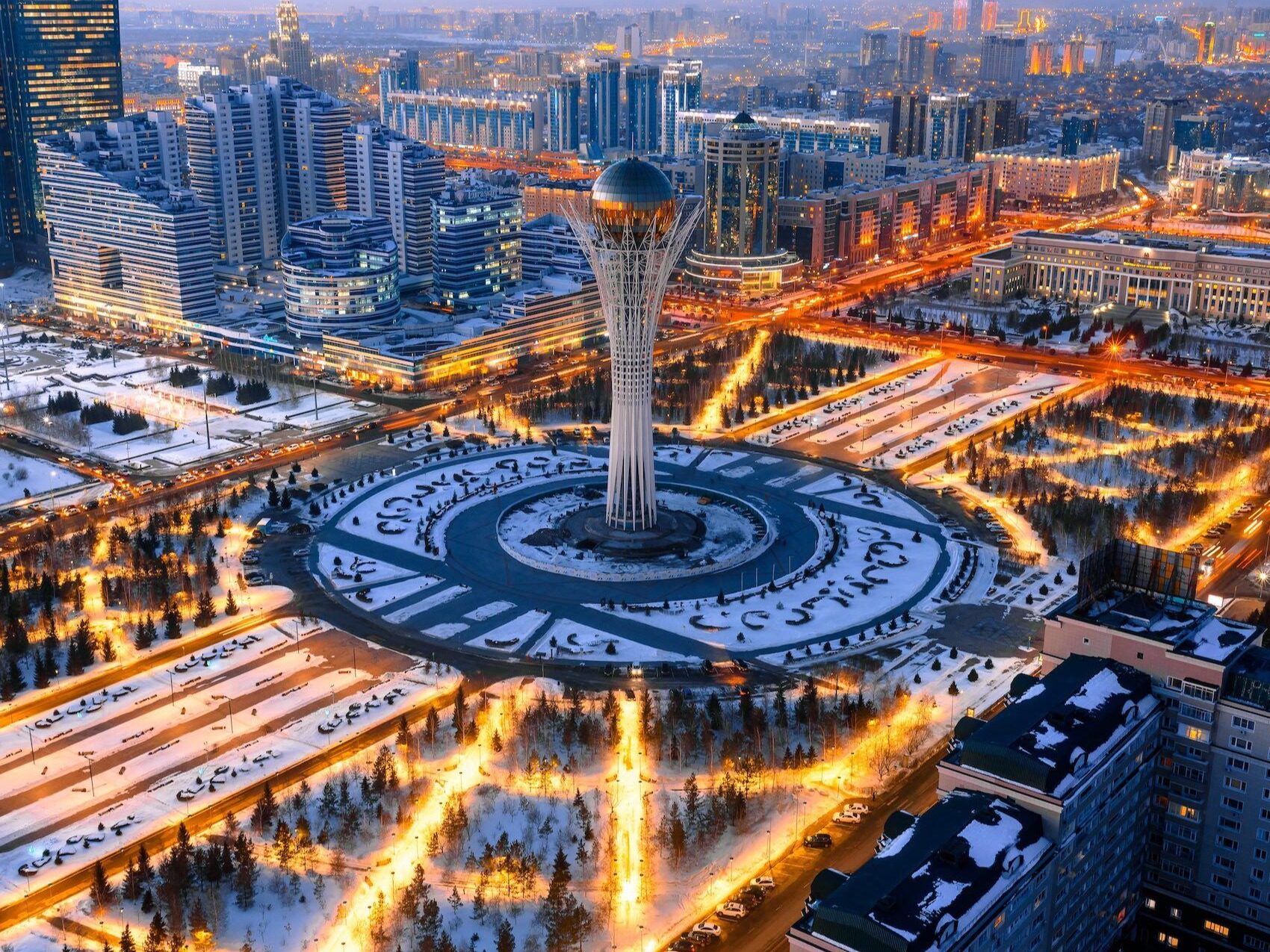- Kanerjing in Xinjiang has a history of more than two thousand years and is still in play today

Walking in the Turpan and Hami basins in Xinjiang, you will see a series of mud packs lined up on the yellowish-brown Gobi Desert. Most of the mud packs are not taller than one person, and there is one every twenty to thirty meters, a string of mud packs. Roughly in a straight line, you can't see the end at both ends. Under this mysterious soil bag, there is a small river that flows continuously all the year round. The channel of the small river is an artificially excavated underground water channel. Every some distance, there will be a vertical earth well to open the stratum on the water channel, and the well heads of these earth wells , Is a small soil bag.
No one can tell when and where Kanerjing began to appear. Although Kanerjing sounds like a well, it is more like a custom-made underground river designed by the working people living in an oasis that draws groundwater for their livelihoods, but is afraid that it will be evaporated. Once, Hasan, a Turkish think tank expert, praised: "The Karez is so spectacular! It is with the hard work and wisdom of the local people that a huge underground water system with a total length of nearly 10,000 miles and consisting of hundreds of wells has been built to benefit the local people. Kanerjing is indeed a veritable underground Great Wall."

As we all know, ancient China was basically based on farming civilization, and water conservancy was the lifeblood of agriculture. Before the age of mechanization, agriculture was completely dependent on the sky. The area within the 400 mm precipitation line is the place where the agricultural civilization is most developed, that is, the Central Plains area in ancient times. Even at the end of the Qing Dynasty, Xinjiang, Tibet, Inner Mongolia, Heilongjiang and other places beyond the 400 mm precipitation line were still in bitter cold areas and few people lived in them. The Kanerjing is the earliest water conservancy project to develop and utilize groundwater in arid areas. It is the crystallization of the wisdom of the ancient working people. Its magical orientation and structure can preserve precious water to the greatest extent and provide enough irrigation and domestic water for people in arid areas.
The miracle of Xinjiang
The Turpan area in eastern Xinjiang is located in one of the four major basins in China and belongs to the Paleo-Western Region. Beginning in the Han Dynasty, Turpan was an indispensable place for the Xiongnu, Rouran, Khitan and other ethnic minorities in the process of their westward advancement, and at the same time, it was also an important place for contending. Therefore, it became an important hub for the Central Plains dynasty to station troops. Relying on the oasis, small-scale ancient cities, such as Jiaohe Ancient City and Gaochang Ancient City, were first established here. But the ability to develop a culturally splendid and large-scale ancient city depends not only on the gift of nature, but more importantly, Xinjiang’s own wisdom-Kanerjing.
Kanerjing is a special underground canal irrigation system in the arid area of Xinjiang. It is mainly distributed in Turpan and Hami in the southern foothills of the Bogda Mountains in eastern Xinjiang. It has a history of more than two thousand years. It leads the undercurrent in the stratum to the ground along the dug culvert, and then introduces it into the farmland or the flood dam from the open channel. The overall engineering volume is very huge and it is also a test of human wisdom. Karez is very common in the arid areas of Xinjiang and is an important guarantee for local agriculture. For more than two thousand years, the Karez, where the wisdom of the ancients was condensed, has been hailed as a miracle in Xinjiang.
The Kanerjing consists of shafts, culverts, open channels and flood dams (small reservoirs). The total length of the underground culvert in the Karez in Turpan is about 5,000 kilometers, plus thousands of shafts, open channels, etc., and the amount of work is huge. When digging underground culverts, the craftsmen squatted or knelt or crawled in the low and low oxygen space, put the oil lamp on their mouths, held the sharp-nosed heads in their hands, and digging bit by bit. It was extremely difficult. It is conceivable. The successful excavation of a kan'er well requires not only the cost of life, but also the continuous efforts of several generations. It is often grandfathers who excavate, and only grandchildren can use the well water.
The standard karez is generally composed of a shaft and a culvert. The shaft is used for positioning, access and ventilation. The soil taken during excavation will form a ring mound around it to prevent ground water from infiltrating; the depth of the shaft and the location of the quarry Depending on the location, the downstream area generally only needs to be about 10 meters deep, and the upstream area may need to be as deep as 100 meters.
Concealed channels are also called water conveyance corridors. There are catchment sections and open channel sections. Generally, the width and height of the culvert can only allow one person to enter sideways, and the length varies according to the water depth, soil quality and other factors. Generally, it is 3 to 5 kilometers. The longest may exceed 10 kilometers. Most of the karez wells located underground have minimized the evaporation of water. In the era when there was no scientific knowledge, the wisdom and courage of the ancestors to construct such a complex water conservancy project only through practice can be seen.
The rise and fall of Kanezai
Kanerjing was founded in the Western Han Dynasty. According to the records of "Han Book • The Biography of the Western Regions": during the Emperor Xuan Dynasty, the Han Dynasty sent General Po Qiang Xin Wuxian to Dunhuang with 5,000 soldiers. Meng Kang, a member of the Three Kingdoms, commented on Beidanhoujing: Dajing No.6, the canal is also open, and the downstream gushes out at the bottom of the Bailongdui Dongtu Mountain.
Kanerjing is called Jingqu in "Historical Records". It is an ancient water conservancy project that uses natural geographical environment to develop and utilize groundwater. Turpan is one of the extremely arid regions in China. The annual precipitation is only 16 millimeters and the evaporation can reach 3000 millimeters. How to attract and retain water is a great test for Turpan residents.
When spring and summer come, a large amount of snowmelt and rainwater flow to the lower basins at the Bogda Peak at an altitude of more than 5400 meters in the north of the Turpan Basin and the Karawucheng Mountain in the west, and infiltrate the gravel soil to form an underground undercurrent. Over time, sufficient water has been stored under the Gobi. People drilled a few vertical wells of varying depths at intervals, and then repaired culverts at the bottom of the wells according to the height of the terrain to communicate with the wells and draw in water. The outlet of the underground channel is connected with the surface channel to lead the groundwater to the surface to irrigate the farmland, thus the Karez was born.
In 1845, Lin Zexu went to the south of the Tianshan Mountains to reclamation, passing through Turpan County, wrote: "See the many earthen pits along the way, ask for their names, say card wells, those who can divert water from the south, gradually higher and higher. Walking through the hole in the soil is truly incredible." He knows that the karez is the lifeline and is committed to developing the karez.
Kanerjing embodies the wisdom of the people of all ethnic groups in Xinjiang and has unique ecological value. It skillfully uses the height difference between the snow-capped mountains and the basin and the geological conditions of the Gobi for excavation, natural drainage, which reflects the harmony between man and nature, and is similar to the Dujiangyan Water Conservancy Project. Kanerjing relies on underground culverts to transport water, which is not affected by seasons, wind and sand, has small evaporation, stable flow, and can be irrigated by gravity all year round. At the same time, the canal water is filtered through sand and stone to form natural mineral water, which is rich in minerals and trace elements. The local residents have been drinking it for hundreds of years. Good name.
Most of the existing Kanerjings in Turpan have been successively constructed since the Qing Dynasty. Today, large oasis fields are still being watered. It is precisely because the Kanerjing has continuously nourished and irrigated the oasis for thousands of years, the vast Gobi has green and glittering grapes, a life of singing and dancing, and the creation of a colorful civilization.
Protection and reinforcement to keep water flowing
Kanerjing is the source of life. The people of Xinjiang have always attached great importance to the maintenance of the Kanerjing, and often carried out dredging and dredging of it to ensure a continuous flow of clear water. In 1874, Zuo Zongtang, who was over sixties, was appointed as the imperial minister to supervise Xinjiang's military affairs. In order to develop the local economy and ensure the supply of military rations, he vigorously set up a farming industry and advocated the strategy of Karez. His achievements have been left to this day. Today, the Kanerjing is still called the Royal Kanerzi by the locals, which means a well dug by the emperor. It still carries the pure water of nature for the Turpan people day and night.
However, at the end of the 1950s, the number of kaner wells reached the highest peak. At that time, there were 1,784 kaner wells of various sizes in Xinjiang, and the irrigated area could reach 24,200 hectares. However, due to the rapid deterioration of the ecological environment, coupled with the continuous increase in population and the growing area of arable land, water resources have been consumed in large quantities, many karezes were forced to be abandoned, and the number of karezes that can still be used has been significantly reduced. Take the Turpan area, which accounts for 70% of the kaner wells in Xinjiang, as an example. From 1957 to 2014, the number of kaner wells decreased by 1,023, and an average of 18 kaner wells disappear every year, and they can no longer perform their original functions. After the 1980s, due to climate warming and reduced precipitation, coupled with the rapid increase of farmland motorized wells, the groundwater level dropped, causing many karez wells to dry up or even disappear.
The disappearance of the Karez led to the continuous decline of the local shallow groundwater level, irreversible changes in the soil structure, a significant increase in the area of local desertification, and a significant decrease in biodiversity. These abandoned karez is also a cultural loss. It is not only a material heritage of water conservancy, but also has considerable historical and cultural value. For the people of Xinjiang, especially Turpan, the Kanerjing has the same status as the mother river, and it is an important part of the traditional well-canal culture of the Chinese nation. On the other hand, Kanerjing has also witnessed the prosperity and development of oasis, and is a milestone in water conservancy and oasis agriculture. Now Kanerjing also has rare tourist value, attracting Chinese and foreign tourists to visit and pay respects.
In the new century, as the karez excavation technique was included in the national intangible heritage list, the karez received attention and protection again. In 2009, the rescue protection and reinforcement project of the Kanerjing kicked off in Turpan. After years of continuous protection, the basic form of the Kanerjing was preserved to the greatest extent and its irrigation function continued. According to statistics, the water output of the Kaner Well after reinforcement and repair has increased by an average of about 30% over the past.

At present, the oldest Kanerjing in Xinjiang is 473 years old, and the daily water output can still irrigate 20 acres of land; the longest Kanerjing is a full 25 kilometers, and the deepest one is 98 meters deep and 20.7 kilometers long. These large and small karez wells are still playing their role in agricultural modernization. As water conservancy engineering facilities with minimal damage to the environment, they guard Xinjiang's agriculture and oasis. The predecessors planted trees, and the descendants took the shade. The invention of Kanerjing not only feeds more people in Xinjiang, but also brings considerable tourism income. It also adds a beautiful touch to China's cultural landscape. Therefore, it is our unshirkable responsibility to protect the karez that is about to disappear. Editor/He Yuting
Comment
 Praise
Praise
 Collect
Collect
 Comment
Comment
 Search
Search














Write something~